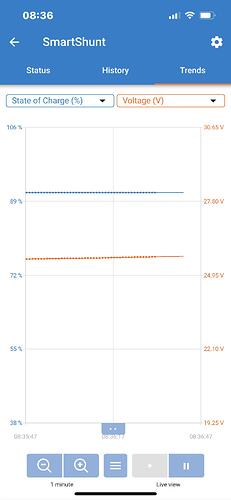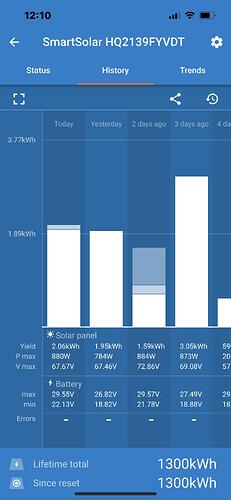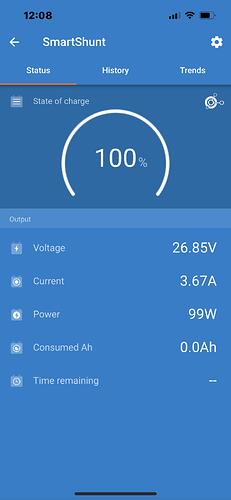Apologies for the obvious newbie question… Other than more solar is there a way to help prevent low-voltage alarms. Yes I only get them when I push the system. I have a Phoenix 24 3000 and when the sunshine is out it successfully runs the washer dryer or even the dishwasher, not at the same time, obviously… ![]() It has a permanent load of a fridge freezer and a few IoT devices. The battery bank is above 80%, with the overcast day today, when the washer started heating the water it popped off. I do have the inverter plugged into the mains and on a smart socket so I can ask Alexa to turn it on rather than going to the workshop. This obviously helps bring the voltage back up. Now the Phoenix was second hand and I don’t know if there are any jumpers that could be changed that would help?
It has a permanent load of a fridge freezer and a few IoT devices. The battery bank is above 80%, with the overcast day today, when the washer started heating the water it popped off. I do have the inverter plugged into the mains and on a smart socket so I can ask Alexa to turn it on rather than going to the workshop. This obviously helps bring the voltage back up. Now the Phoenix was second hand and I don’t know if there are any jumpers that could be changed that would help?
What batteries, how old if lead acid, what temperature are the batteries at and how do you know the SOC. If not set up right or regularly charged fully the SOC can drift and read a lot higher than actually is the case. Some cheap drop in lithiums have a BMS that does not measure small currents, so the batteries discharge without the SOC falling. A full charge clears the error, otherwise it keeps increasing.
The batteries are 2 years old 6x Varta C40 12v 240Ah 1200A, it’s about 12 degrees in the workshop. I have a Vicctron Bluetooth Smart Shunt on and I use the app to see the SoC and the Trends. I took this setup photo halfway through the build I now have 6 batteries. The Smart Shunt Screen grabs are from this morning.
I am going to assume you mean 12 degree C, so not so cold to be a worry.
You know with lead acid that they need to be regularly charged to 100% for long life and that not charging them to 100% damages them. Have you regularly been getting to full absorption voltage (about 29V). A 30A MPPT to charge 720Ah of batteries is very small. I wonder if you have been undercharging them and they now have reduced capacity. Supply some of the history screenshots.
You need to check what solar power you are generating compared to your use and how long to recharge the batteries after a heavy use. More solar might be the answer, lithium batteries might be as they do not need to be recharged to 100% regularly like lead acid.
If they have not been fully charged regularly, then the SOC becomes inaccurate. It relies on the batteries getting to 100% regularly to resynchronise and correct the drift in the SOC reading.
Finally, what absorption voltage do you have on the MPPT and what is your “charged voltage” setting on the SmartShunt. Share screen shots of your settings. See the link which describes how the SOC can read high and what the SmartShunt settings should be.
When you say 100% regularly… Are we talking daily/weekly/monthly as I sit in the several times weekly at least in winter. As I know my old second had pannels aren’t great Peak 250w when new… you can see on this high cloud in Yorkshire day I’m not genarating much. That all said Monday, Wednesday and Saturday I use my cheaper EV tarrif to charge for 4 hours. Here are the screen grabs I’ve just gone for. Charged from 91% to 100% and run the kettle 3 times and the perminant load of the IoT devices and the Fridge Freezer.
If you are fully charging 2-3 times a week that is not so bad on the batteries. You will still have put a lot of cycles on them over 2 years so there may be ageing at play even though the gauge has not counted many full cycles (needs to go below 60% SOC I recall).
On your SmartShunt, increase the charged voltage to 28.6V or 0.2V below absorption to avoid getting erroneous synchronisation to 100%. If you have had some syncs to 100% before full then that could catch you out on low voltage.
An important step whenever you have any low-voltage-at-high-current issues is to check your cabling.
Even cabling that was tested as good on install could have developed a loose connection with thermal changes.
With the system under a heavy load, either charge or discharge, your drop should not be much more than a few tenths of a volt.
So … What are your voltages at A, B, C, D and E from the diagram above?
If any pair of readings are more than 0.1v, do another check;
- Put your negative probe on the source (so the inverter if you are hard charging, or the battery if you are hard discharging) and check the positive points A, B, C, D and E.
- Repeat with your positive probe on the source.
You are looking for any difference that is more than 0.1v - hopefully you have a DMM with 2dp or more, and probes in good condition.
I just checked one of my systems using a Tenma load (it has a pretty precise voltage meter - not sure on the accuracy, but the precision is good, and we are looking at the relative numbers), charging at 68A over 35mm cable, the voltages were;
Inverter 52262 mV
MCCB top 52243 mV
MCCB bottom 51978 mV
Shunt 51973 mV
Battery busbar 51950 mV
Battery terminals 51938 mV
19mV in the first cable - thats ok
265mV dropped in the MCCB! at 68A that’s 18 watts - its going to heat up a bit.
5mV in the next cable - thats ok
23mV from the shunt to the battery busbar - ok.
This is a demo system, no special prep on the lugs, and not torqued correctly yet, so i’m happy, but i wouldn’t be happy with this on my home. If i were to take those lugs off and polish their bearing surfaces on a flat emery board, then re-torque the bolts on the MCCB, i’m sure I could get that drop down a bit.
One factor that made this test non-scientific is that the day was patchy with clouds coming over and the current was going from about 30A to over 85A, so this requires watching the current, and when it hits the same number (in my case 68A), take samples at this time, which i wasn’t very accurate at doing.
Looking at this compared to a theoretical voltage drop calculator, if there were no connections (i.e plain 35mm copper with no lugs), there should be less than 0.1v overall, so i’m a long way above the theoretical drop that the copper is capable of.
Does anyone know the typical voltage drop over a well-torqued lug? i.e a value we should be aiming for?
Right oh I’ll let the system go down below 60%
Noooo. I mentioned the 70% SOC to trigger the SmartShunt to count it as a full cycle which is why you have so few cycles registered. It is not a target for good performance, keeping the cycles smaller gives you longer life.








